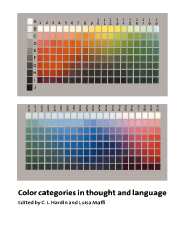Book contents
- Frontmatter
- Contents
- Notes on contributors
- 1 Introduction
- I THE WORLD COLOR SURVEY
- II VISUAL PSYCHOLOGISTS
- 3 The psychophysics of color
- 4 Physiological mechanisms of color vision
- 5 The neuropsychology of color
- 6 Insights gained from naming the OSA colors
- 7 Beyond the elements: investigations of hue
- 8 Color systems for cognitive research
- III ANTHROPOLOGISTS AND LINGUISTS
- IV DISSENTING VOICES
- 16 Closing thoughts
- Subject index
- Author index
3 - The psychophysics of color
Published online by Cambridge University Press: 20 August 2009
- Frontmatter
- Contents
- Notes on contributors
- 1 Introduction
- I THE WORLD COLOR SURVEY
- II VISUAL PSYCHOLOGISTS
- 3 The psychophysics of color
- 4 Physiological mechanisms of color vision
- 5 The neuropsychology of color
- 6 Insights gained from naming the OSA colors
- 7 Beyond the elements: investigations of hue
- 8 Color systems for cognitive research
- III ANTHROPOLOGISTS AND LINGUISTS
- IV DISSENTING VOICES
- 16 Closing thoughts
- Subject index
- Author index
Summary
General introduction
Properties of visual photopigments
The only way light can influence the eye is by something in the retina absorbing quanta. That something is the visual photopigment found in the outer segment of the photoreceptors, the rods and cones. When a molecule of photopigment absorbs a quantum, the molecule changes its shape. This is the only direct effect that light has on the eye. All subsequent events are chemical reactions that do not require light. One particularly important, but not well understood, reaction is the amplification of this tiny event into a definite change of the receptor's membrane potential, which in turn causes the synaptic activity exciting the next cell in the pathway.
One of the most important characteristics of any photopigment is the relative probability of its absorbing photons from different regions of the spectrum. This aspect of a photopigment may be called its spectral sensitivity – or better yet, its relative spectral absorption. The best-studied photopigment is rhodopsin, the one found in rods. Rhodopsins from different animals have slightly different relative absorption spectra although most have maximal sensitivity around 500 nanometers (nm). Figure 3.1 shows the curve for human rhodopsin. Notice that it is most sensitive at about 500 nm and falls off gradually on either side of that wavelength. For example, the probability of absorbing quanta at 448 or 536 nm is only half of what it is at 500 nm.
- Type
- Chapter
- Information
- Color Categories in Thought and Language , pp. 59 - 88Publisher: Cambridge University PressPrint publication year: 1997
- 11
- Cited by



